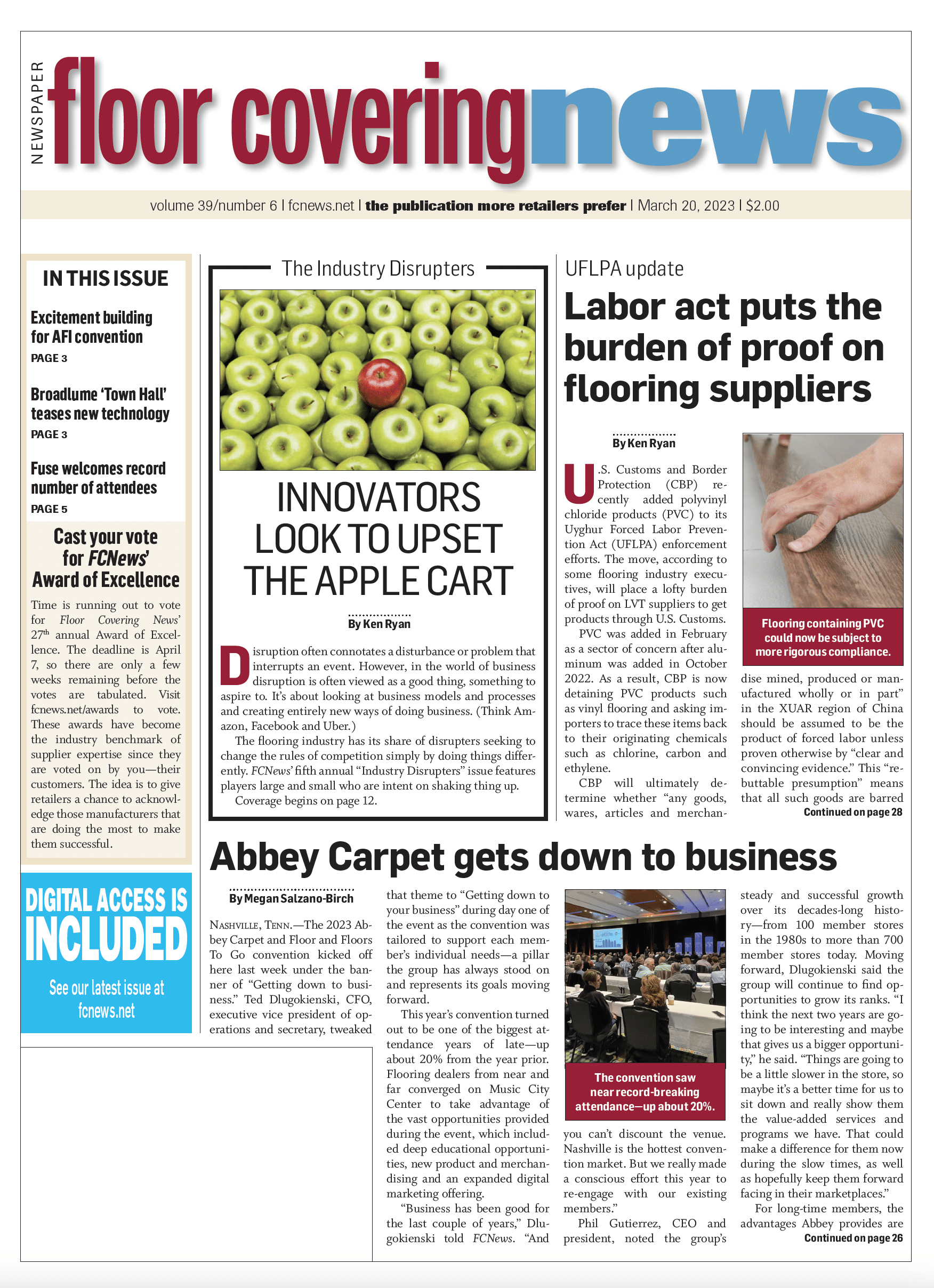 Disruption often connotes a disturbance or problem that interrupts an event. However, in the world of business disruption is often viewed as a good thing, something to aspire to. It’s about looking at business models and processes and creating entirely new ways of doing business. (Think Amazon, Facebook and Uber.)
Disruption often connotes a disturbance or problem that interrupts an event. However, in the world of business disruption is often viewed as a good thing, something to aspire to. It’s about looking at business models and processes and creating entirely new ways of doing business. (Think Amazon, Facebook and Uber.)
The flooring industry has its share of disrupters seeking to change the rules of competition simply by doing things differently. Floor Covering News’ Industry Disrupters 2023 issue features players large and small who are intent on shaking thing up.
This year, disruptors fall under the following categories:
Artificial Intelligence
Artificial Intelligence (AI) has been looming over our heads for quite some time now but has only recently found a home within the flooring industry. Whether through adaptive language technology capable of creating useable marketing and editorial materials as well as immeasurable potential for a variety of collateral, training and even management services to the next generation of customer service, AI is slowly but surely making a name for itself in flooring with the potential to immensely disrupt the way we do business.
- ChatGPT
- Smith.ai
Technology
The flooring industry has historically been slow to embrace technology and all its iterations, but as a new generation emerged and began to take up the reins, technology has been thrust into the limelight. Several software technology companies have stepped up to the plate to deliver industry-disrupting innovation meant to take the limits off retail and its service to the consumer.
- Mohawk Omnify+
- Mobile Marketing
- SamplesApp
- Roomvo
Labor
FCEF
It’s an ongoing industry problem—a lack of qualified installers as a result of veteran flooring mechanics “aging out” amid a dearth of new blood coming into the industry. While established organizations like CFI, NWFA, NAFCT and the like have certainly done their part to elevate the training level and professionalism of flooring installers, few have focused attention on the recruitment level—until now.
Created by the World Floor Covering Association (WFCA) to bring awareness to the opportunities available within flooring, the mission of the Floor Covering Education Foundation (FCEF) is to recruit a new generation of installers and fund [through scholarships] new recruits and help facilitate available industry training that leads to job placement. It’s a tall order, and the FCEF leadership team led by Jim Aaron, executive director, and Kaye Whitener, director of operations, has by all accounts achieved more than could have been expected. But more needs to be done, and it will take the industry’s collective efforts.
Less than two years into its existence, FCEF can claim at least one major achievement, which is the approval and accreditation of the Basic Floor Covering Installation program. Created in partnership with CFI, CTEF and NWFA through the Technical College system, it has allowed college-age people to earn an associate degree in installation—the first major step to full-time employment. FCEF initially piloted a 10-week Basic Flooring Installation program at Georgia Northwestern Technical College (GNTC).
Distributor Consolidation
The flooring distribution industry is growing even as it consolidates, with eight of the Top 20 wholesalers already doing revenue of $200 million or more annually—a first for the industry. Consolidation within the distribution ranks has accelerated in recent years, with larger distributors buying out smaller players and large private equity firms getting into the act by acquiring companies larger and small.
- The Merit Distribution Group
- Crown Products
- Belknap-Haines
- Galleher
Logistics, Sourcing
A relative few flooring suppliers have the resources and scale to purchase their own fleet of trucks to distribute their own products or perhaps even charter a shipping vessel to transport goods from halfway across the world. Those that can do take advantage of logistics opportunities and global sourcing to procure the best products for their customers.
- Republic
- MSI
Economy
Federal Reserve moves
Primarily fueled by pent-up consumer demand amid a pandemic-stricken economy, the rate of inflation has risen markedly since mid-2020 and remains stubbornly high. As of press time, the rate of inflation, as determined by the consumer price index (CPI), was 6%. While that’s down a smidge from a high of 8.4% this time last year, the needle has barely budged despite eight consecutive rate hikes by the Fed—too much, too often, critics say.
While the window for a so-called “soft landing” has clearly closed, the challenge for the Federal Reserve now is to strike a better balance between reigning in higher prices for a host of consumer goods and services (including food and energy) and slower economic activity and the prospect of belt-tightening by consumers. The Fed has long stated that its intent is to bring the rate of inflation down to a paltry 2%, admitting that it is willing to trade off higher unemployment to achieve that goal. Many prominent economists warn of the dangers of that target in addition to the rapid pace of rate increases that we have seen in the past 10 months alone.
“The Fed is looking to exact its pound of flesh from the U.S. economy,” stated Alan Beaulieu, president of ITR Economics. The firm, which has a 97.4% accuracy rate in predicting economic upturns and downturns, now says these moves by the Fed will touch off a mild recession in the U.S. in 2024, with a projected rebound in 2025.
Alternative Cores
While the number of rigid core flooring participants has grown to an immeasurable size and SPC/WPC products can be found in a variety of forms, there are some suppliers who stand out from the crowd. Utilizing innovative core technologies, these manufacturers are taking rigid core to the next level. For some, sustainability is their common ground along with a penchant for doing right by people and the planet while for others it’s about providing industry-leading innovation retailers can sell.
- Benchwick
- Nox
- Shaw
Antimicrobial protection
Interest in “clean” product lines was minimal at best before the pandemic age. However, catastrophe struck in 2020 and consumers across the country were clinging to any solution that could bring them a little peace of mind. For flooring, the solution was antimicrobial protection. A game-changer for the industry, these treatments were not the topical treatments of yesteryear but were incorporated into the product itself and able to last the life of the install. Consumers were given 24/7 protection without the need for upkeep.
- Mannington/Phenix
- Daltile
- Lauzon
- Torlys
Lightweight SPC
When SPC products first entered the market, they were designed as a more rigid, durable alternative to WPC. But along with the heavier, denser SPC cores comes additional weight, which translates into higher shipping costs as well as heavier boxes for installers to bring to the job site. To remedy these issues, product innovators have come up with creative ways to reduce product weight without compromising durability.
- Bjelin (Liteback)
- i4F (Be-Lite)
- Unilin Technologies (Light SPC)
Merchandising, Marketing
The importance of a well-merchandised store cannot be overstated. It’s an effective way of helping to convert more browsers or window shoppers into customers by removing their confusion and helping them choose between multiple products more quickly. In the flooring industry, buying groups and manufacturers alike are pursuing the same goal: simplify the shopping experience to increase profitability for dealers and RSAs.
- Broadlume
- CCA Global
- Daltile Statements
- RIVA
- Cali
Visuals/Textures
While performance attributes are high on the list of consumer needs and desires when shopping for flooring for their renovation projects, the final selection almost always comes down to how the product looks and, secondarily, feels. Following are some standout innovations in the visual and texture departments.
- Mohawk
- Engineered Floors/Dream Weaver
Direct Digital Printing
A hard surface flooring suppliers look to further differentiate themselves from competitors, technology providers are doing their part by leveraging innovations that open up opportunities to create more unique, longer-lasting visuals. One such innovation—albeit a costly one to implement—is direct-to-core digital printing. This emerging and rapidly evolving technology brings pattern design to a whole new level.
- Benchwick
- i4F
- Unilin Technologies
- Bjelin
- Inhaus
Diversification
Diversification into non-flooring products like cabinets and countertops is uncharted waters for many traditional suppliers who prefer to stick to their knitting and focus on the products they’ve profited from over the years. But there are a handful that have ventured into categories beyond flooring to seek out new revenue streams and differentiate themselves from the competition.
- Southwind
- Hallmark
For the full feature, visit the March 20, 2023 edition of Floor Covering News.

